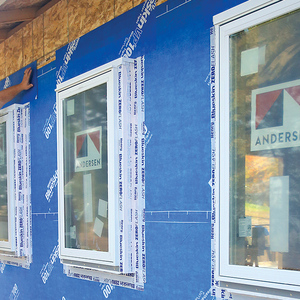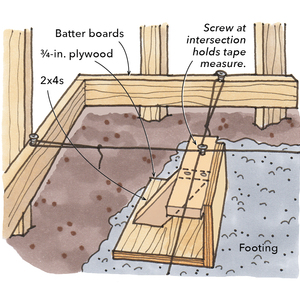During hard rains, water appears around the interior of several windows of my daughter’s house. The house is clad with wood shingles. This has been an ongoing problem since the house was built 16 years ago. The exterior window trim has rotted. The trim has been replaced and in the process the top nailing flange recaulked. This has not helped. We suspect that the house wrap was torn during construction and taped and that the repair does not prevent water from getting behind the house wrap. Is there anything short of removing all the shingles and rewrapping the house that will solve this problem?
Discussion Forum
Discussion Forum
Up Next
Video Shorts
Featured Story

The Titan Impact X 440 offers great coverage with minimal overspray.
Highlights
"I have learned so much thanks to the searchable articles on the FHB website. I can confidently say that I expect to be a life-long subscriber." - M.K.
Fine Homebuilding Magazine
- Home Group
- Antique Trader
- Arts & Crafts Homes
- Bank Note Reporter
- Cabin Life
- Cuisine at Home
- Fine Gardening
- Fine Woodworking
- Green Building Advisor
- Garden Gate
- Horticulture
- Keep Craft Alive
- Log Home Living
- Military Trader/Vehicles
- Numismatic News
- Numismaster
- Old Cars Weekly
- Old House Journal
- Period Homes
- Popular Woodworking
- Script
- ShopNotes
- Sports Collectors Digest
- Threads
- Timber Home Living
- Traditional Building
- Woodsmith
- World Coin News
- Writer's Digest


















Replies
You may not need
to strip the whole house, but you do need to strip the area around each window that's leaking, remove the window, install a pan, re-wrap the opening while tying into the existing wrap, and re-install the window (or a new one). Sounds like they omitted pans and probably made other mistakes too.
You may find a lot of damage in the process that you didn't suspect. If raw cedar shingles were installed over Tyvek you may end up stripping the house.
Pans ?
What do you think of Tyvek Flex Wrap instead of pans on windo installs ?
I used it on my garage a few years ago. The garage is unfinished inside and I did not foam around any of the windows (6), so I have been able to watch for any leaks. So far everthing looks good. I also used Tyvek straight flashing tape over the flanges.
When I ask about flashing pans around here (Louisville, KY) I get that deer in the headlights look, even at my regular lumber yard (not a big box).
Just courious if anyone else has used flex wrap and how it has performed for them.
Vycor type flashing tape I have used often
Pans were not readily available here either, so when the idea of panning windows/doors came to my attention (probably here) I have utilized the flexible flashings to fab my own.
I have no jobs that have remained uncovered and have had no reports of problems surfacing.
Before panning I did nothing other than tried to detail the exterior so the second line of defense wasn't necessary With no aftercalls on problems, beats me on the results of those attempts at weatherproofing.
I've only done a few vynal jobs which I think can be the hardest to seal up penetrations that last.
I can't imagine that panning a regular window in standard frame construction would ever be necessary or beneficial. More likely to create problems than prevent them.
Dan
Some window manufacturers have not / do not use much of a bottom "flashing", especially on dbl hungs. Those that have changed to full flange are including in the installation details the use of "flexible flashing" at the bottoms of the rough openings.
So, like it or not it has become "commonplace" to install a "pan" of sorts on all window installs.
Same goes for doors which do not have a bottom flange or brickmold wrap.
I understand your question to possibly mean that it would act to trap moisture and possibly leave the "ears" of the window jamb sitting in and wicking up moisture.............I think.
However, the panning detail is mainly to keep water that "might" leak in from entering the interior.
As a remodeler I have opened up a whole lot of previously installed windows and can tell you that detailing is minimal at best. Caulk seems to be the tool/design of choice at waterproofing.
Almost all damages are at the bottom of the window/opening.
Caulk ?
I have the Moisture Control book by JLC and it recommends caulking under the flanges except for the bottom flang. With a pan or flex wrap the uncaulked bottom flang at least offers a way out for any moisture that may have gotten that far.
The book also say to use a latex caulk, but that seems a little weak to me. I've yet to see a latex caulk that held up over a long period of time. What type caulk are you using under the flanges ?
Caulk
I use at the least, a butyl caulk like OSI offers. Urethane if I have it. Have found a nice caulk from Titebond-Weathermaster Sealant-but, you'd better use it up soon. I've found no way to keep it from hardening in the tube yet.............and I've tried many things. Even the slit the snout, pull out the plug and then tape it back up-it hardens well beyond the snout. Hardens isn't a good word-still flexible and adheres well.
Yes, leaving the bottom uncaulked allows water a means of egress.
Just did a repair yesterday, no felt behind vinyl. which runs from top of short brick veneer. Felt behind the veneer tho. Open bottomed J-channel runs down the side of the corner trim-ends into another J at the bottom of the siding. Water in the J that travels down, dumped at the bottom corner of cedar corner board which sits on a cedar "brick mold" that sits on top of the brick veneer.
There was a metal flashing below the bottom J-channel on top of the brick mold...............but this was cut stopped at the corner board.
Cedar corner rotted, brick mold at that corner rotted, osb sheeting rotted and partial rot of corner framing..............
14 yr old house.
J-channel, the bane of vinyl siding.
Windows leak!
Vinyl windows are made by welding the corners together... those welds sometimes break due to handling or thermal expansion/contraction. Aluminum windows and wood/clad windows use sealant and fasteners in the corner... sealant dries out and pulls apart or fails for other reasons. In any case, during the lifetime of the building there is likely to be a problem, and the pan is what will keep the framing from getting wet. If you have not dealt with a window leak you are not doing much building. I have seen new construction windows leak thru the frame and onto the sill during the first rain. I have seen many 10-20 year old houses with window leaks, in fact I just repaired such a problem and have another one to do.
What problems do you think a window pan would cause?
I use Flexwrap
most of the time and custom made galv or copper pans the rest of the time. If using Flex I first nail a piece of 1/2 x 6 cedar bevel siding to the rough sill to create slope to the outside. I foam around the perimeter of the window after it's installed with Hilti low expanding foam. If you don't want to use foam, get yourself an assortment of closed-call caulk backer rod and use that instead. Do something, otherwise there will be a lot of air leakage around your window installs.
solve this problem?
Usually the best way to figure this out is on site, answering a question like you have is almost impossible without a boatload of more information.
It used to be that window installs were just slather on caulk behind where the nailing flange will go and nail the snot out of it. Sometimes they added a head flashing and that was it.
The first line of defense was the caulk around the trim/window frame and maybe at the siding/trim junction.
Now, there are more detailed instructions from window manufacturers on how they want it flashed. The same went with house wrap-many just stapled it up, cut x's at the window / door openings and still just caulked behind the window flange.
Can you post a picture of the typical install? Might show a possible point of water entry. A closeup or two on corners, the top of the window/trim and at least a step back so we can see the window in the side of the house. Sometimes water enters above-works its way down and the first opening it runs into is a window-where it makes it's appearance.
If all the trim was removed I would think that would have been the perfect time to really get a handle on what might be going on. That it rotted can be a direct result of not sealing the ends/cuts of the trim (what kind is it?), even the way it was installed. Of course a soaked backside on unpainted trim will rot also.
It would help to know where this is and what the climate is.
But as the others indicated, it's difficult or impossible to diagnose from this distance (or even 20 feet away). Could be water leaking from the roof or gutters, could be getthing through the shingles, running down the sheathing, and finding a way in, could be getting through the trim joints, could be getting through a defective/inferior window itself. Could even be condensation due to excessive indoor humidity.